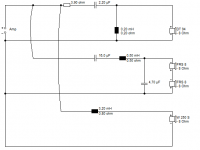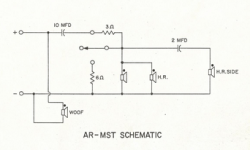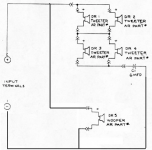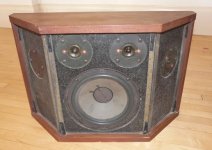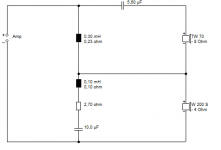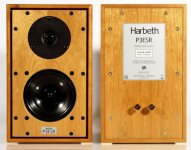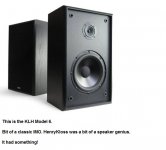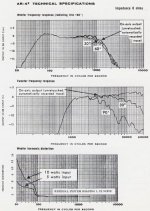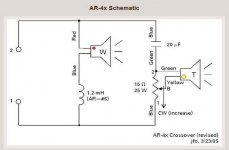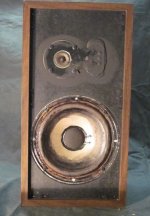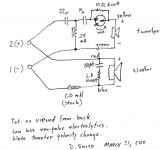You must appreciate, snup, that some of us care about carefully crafted speakers and posts. TBH, when you get to my age, you want to get there FAST, because you don't have time to waste. 
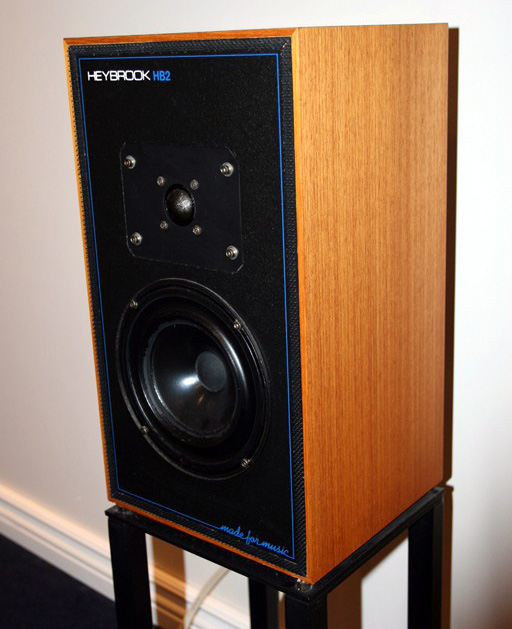
The Heybrook HB2 is still sufficiently interesting and listenable that it is still available in Wilmslow Audio's current DIY Homage with modern drivers: WA HB2 Loudspeaker
Marvellous.

The Heybrook HB2 is still sufficiently interesting and listenable that it is still available in Wilmslow Audio's current DIY Homage with modern drivers: WA HB2 Loudspeaker
Marvellous.
The Heybrook HB2 is still sufficiently interesting and listenable that it is still available in Wilmslow Audio's current DIY Homage with modern drivers: WA HB2 Loudspeaker
Marvellous.
I see they've got an HB1 clone too.
The HB1 is using the Vifa M21WG which is a lively foamed 8" bass.
TBH, snup, you are walking a fine line, which earns you a certain tolerance. In your favour is that you evidently build speakers, and listen to the results. My own view is that all speakers are compromised.
So I get kinda bored when people talk about open baffles and horns an' all that stuff. Like it's the last word or Audio Nirvana.
My own view of a good post is one that answers the previous one, and advances the science. Here's my favourite speaker of all time. Rubbish crossover, TBH, but great midrange, the Wharfedale E70 (E for EFFICIENCY):
TBH, snup, you are walking a fine line, which earns you a certain tolerance. In your favour is that you evidently build speakers, and listen to the results. My own view is that all speakers are compromised.
So I get kinda bored when people talk about open baffles and horns an' all that stuff. Like it's the last word or Audio Nirvana.
An externally hosted image should be here but it was not working when we last tested it.
My own view of a good post is one that answers the previous one, and advances the science. Here's my favourite speaker of all time. Rubbish crossover, TBH, but great midrange, the Wharfedale E70 (E for EFFICIENCY):
An externally hosted image should be here but it was not working when we last tested it.
Attachments
Last edited:
System7, medium-efficiency (92~95 dB/watt/meter) direct-radiator commercial speakers are still relatively rare, and your comments are interesting and worthwhile. There's nothing wrong with a basic two-way format; the trick is finding mid-woofers with smooth and well-behaved rolloff regions and good-sounding tweeters with efficiencies higher than the usual 91 dB/watt/meter.
Although polar patterns are a little difficult, a pair of good-quality 8" mid-woofers (with smooth rolloffs!) and a modern AMT-style tweeter ought to get efficiency in the 95 dB/watt/meter range. The AMT should have enough muscle to get down to 2 kHz, which is pretty much impossible for ribbons, and not so good for dome tweeters, either, unless loaded with a waveguide.
With modern design techniques, there's no reason that BBC/Spendor/Rogers monitor quality can't be enjoyed with efficiency 8~10 dB higher than the very heavy Bextrene-cone speakers of the mid-Seventies. That means cooler voice coils, more headroom, better dynamics, and a broader choice of amplifiers (including Class A).
Although polar patterns are a little difficult, a pair of good-quality 8" mid-woofers (with smooth rolloffs!) and a modern AMT-style tweeter ought to get efficiency in the 95 dB/watt/meter range. The AMT should have enough muscle to get down to 2 kHz, which is pretty much impossible for ribbons, and not so good for dome tweeters, either, unless loaded with a waveguide.
With modern design techniques, there's no reason that BBC/Spendor/Rogers monitor quality can't be enjoyed with efficiency 8~10 dB higher than the very heavy Bextrene-cone speakers of the mid-Seventies. That means cooler voice coils, more headroom, better dynamics, and a broader choice of amplifiers (including Class A).
Last edited:
AhemSo I get kinda bored when people talk about open baffles and horns an' all that stuff. Like it's the last word or Audio Nirvana.
An externally hosted image should be here but it was not working when we last tested it.
With modern design techniques, there's no reason that BBC/Spendor/Rogers monitor quality can't be enjoyed with efficiency 8~10 dB higher than the very heavy Bextrene-cone speakers of the mid-Seventies. That means cooler voice coils, more headroom, better dynamics, and a broader choice of amplifiers (including Class A).
And if we want reasonable LF extension at that sensitivity, that's gonna require a big box thanks to Hoffman's Iron Law, no? A lot bigger than the 2 cu ft of a Spendor BC1 or LS3/6...
And if we want reasonable LF extension at that sensitivity, that's gonna require a big box thanks to Hoffman's Iron Law, no? A lot bigger than the 2 cu ft of a Spendor BC1 or LS3/6...

Funny how even elaborate minds aren't able to avoid pitfalls. In a traditional design there is always a tradeoff between size, lower rolloff frequency and efficiency.
Funny how even elaborate minds aren't able to avoid pitfalls.
Who's minds? It was not Lynn Olson's responsibility

And if we want reasonable LF extension at that sensitivity, that's gonna require a big box thanks to Hoffman's Iron Law, no? A lot bigger than the 2 cu ft of a Spendor BC1 or LS3/6...
That's what self-powered subwoofers are for. Unlike the Seventies, they're common as dirt, thanks to home theater, which didn't exist back then. (The biggest TV screens were 25" diagonal, and TV sound was low to mid-fi mono.)
I've lived with BBC-type monitors and set them up at the Chicago CES show. Power-handling in the deep bass was low by modern standards, since the midbass drivers of the day were about 85 dB/watt/metre efficient, had paper VC formers that would scorch and burn if exposed to more than 60 watts, and the VC formers of the popular KEF and Audax drivers would smack against the end stops of the internal magnet structure with a nasty rattle. Do that often enough, and all the wiring on the voice-coil would end in a scrunched-up ball on the former ... I've seen it more than once with speakers that were returned for so-called "warranty repair" to Audionics.
So in addition to low efficiency, deep bass drive in the sub-60 Hz region could destroy the speaker if you had a powerful enough amplifier. Woofer destruction was pretty common back then, because BBC-style monitors were never intended for big American living rooms and American's fondness for Big Power (Ampzilla, Crown DC300, Phase Linear 700, the big Audio Research amps, etc. etc.)
This is all in the past, thankfully. Paper formers are pretty rare now, spiders are designed so the VC formers can't hit the end stops, and heavy, low-efficiency Bextrene cones are long gone. And we have subwoofers. Lots and lots of subwoofers, for everything from cars to TV soundbars to mass-market 5 and 7-channel home theater. Since modern subwoofers are coupled with enormous power amplifiers, they're designed for excursions that were unimaginable back in the Seventies ... there were no boom cars back in the 8-track days.
We live in a different world now. The THX specs have set an expectation that any modern, competently designed loudspeaker remains reasonably linear up to 105 dB (at the listening position, not at 1 meter distance). There was no THX standard back then, no home theater, and subwoofers were pretty exotic and expensive. There were a number of audiophile-oriented speakers that would be lucky to hit 95~98 dB before something really bad happened.
Last edited:
The tweeters were always the first thing to go at parties back in the seventies IIRC. About 8 Watts long term was it IIRC. Bextrene and those old Dalesford polypropylene midrange cones seemed to go soft and kinda melt, but kept working. 
We haven't had much on-topic discussion in this Classic Monitors thread recently, which is a disappointment. Because the Audio Note AN-E and the Wharfedale E70 are quite inspiring high efficiency, high dynamics sort of speakers IMO. All about high Qms according to Troels. Well, at least he has a plan these days, whereas the diyaudio recent dynamics thread spluttered into inconclusiveness.
Another thing that interests me is what happens to the tweeter sound when you put resistance in a crossover in all the various ways. Obviously that affects the Qes and hence the Qts. You could eliminate variations with careful impedance correction as with the Audio Note Fs correction, and maybe even a Zobel for the very high frequencies. Don't know. I'm still experimenting.
Today's speaker usually gets a big yawn from the afficionados here, because they want to show off their knowledge of COMBING! Oh God, don't people go on about something that really never bothers me.
Presumably Edgar Villchur and Roy Allison had some input on the Acoustic Research MST. If you don't know who they were, read the article. Really.
The AR MST is a sort of poor man's AR LST, which was a highly respected three way used in auditoriums. It was actually a very small speaker (maybe 10-15L, IDK offhand) designed to work close to a wall. It came in 3 and 4 tweeter versions.
The COMBING bores miss what is great about this speaker. It's designed to solve the power handling problems with the tweeters which go pretty low crossover. Twin tweeters gain 6dB and the sideways firing units help dispersion. Lynn mentioned the dearth of tweeters that can do 1.5kHz. I can only think of a handful myself. The wall mounting makes life easier too. Another way to get 6dB gain and reduce the Allison Bass suckout effect and reduce bafflestep.
The crossovers are interesting, though I'd do things differently these days. The Visaton W200S - 4 Ohm on a series crossover might work well in a design like this. It runs pretty well without a bass coil. After all, we really look to the old classics and masters for inspiration.
We haven't had much on-topic discussion in this Classic Monitors thread recently, which is a disappointment. Because the Audio Note AN-E and the Wharfedale E70 are quite inspiring high efficiency, high dynamics sort of speakers IMO. All about high Qms according to Troels. Well, at least he has a plan these days, whereas the diyaudio recent dynamics thread spluttered into inconclusiveness.
Another thing that interests me is what happens to the tweeter sound when you put resistance in a crossover in all the various ways. Obviously that affects the Qes and hence the Qts. You could eliminate variations with careful impedance correction as with the Audio Note Fs correction, and maybe even a Zobel for the very high frequencies. Don't know. I'm still experimenting.
Today's speaker usually gets a big yawn from the afficionados here, because they want to show off their knowledge of COMBING! Oh God, don't people go on about something that really never bothers me.
An externally hosted image should be here but it was not working when we last tested it.
Presumably Edgar Villchur and Roy Allison had some input on the Acoustic Research MST. If you don't know who they were, read the article. Really.
The AR MST is a sort of poor man's AR LST, which was a highly respected three way used in auditoriums. It was actually a very small speaker (maybe 10-15L, IDK offhand) designed to work close to a wall. It came in 3 and 4 tweeter versions.
The COMBING bores miss what is great about this speaker. It's designed to solve the power handling problems with the tweeters which go pretty low crossover. Twin tweeters gain 6dB and the sideways firing units help dispersion. Lynn mentioned the dearth of tweeters that can do 1.5kHz. I can only think of a handful myself. The wall mounting makes life easier too. Another way to get 6dB gain and reduce the Allison Bass suckout effect and reduce bafflestep.
The crossovers are interesting, though I'd do things differently these days. The Visaton W200S - 4 Ohm on a series crossover might work well in a design like this. It runs pretty well without a bass coil. After all, we really look to the old classics and masters for inspiration.
Attachments
With modern design techniques, there's no reason that BBC/Spendor/Rogers monitor quality can't be enjoyed with efficiency 8~10 dB higher
What do you mean with "BBC/Spendor/Rogers monitor quality"?
There are many people who tried to "clone" these monitors. Some only clone the look of it (which is small square box). Some included the mounting techniques. But what characterize these speakers? Being a monitor like many of ATCs?
So soundwise, what is the characteristics of an LS3/5A for example? I think it can be seen from the speaker response. But subwoofer + satellite will not be the same, right?
Interested as I am in anything that Lynn Olson has to say about speakers, I can answer your off-topic (because we are talking about the AR-MST here, IIRC!) query myself. 
The BBC used BW3. That's it really. It's somewhere between Troels' preferred LR2 and Zaph's preferred LR4. And perfectly valid as a solution. Swings and roundabouts. Choose your poison.
You might think an updated Harbeth P3ESR, which is a modern equivalent of the LS3/5A speaker is audio nirvana, but really the bass is non-existent. The BBC LS3/5A was designed to be used in a tiny Van at an outdoor concert.
Me, I'd use a three way at home or in the studio: http://www.troelsgravesen.dk/ScanSpeak-3W-Discovery.htm
The BBC used BW3. That's it really. It's somewhere between Troels' preferred LR2 and Zaph's preferred LR4. And perfectly valid as a solution. Swings and roundabouts. Choose your poison.
You might think an updated Harbeth P3ESR, which is a modern equivalent of the LS3/5A speaker is audio nirvana, but really the bass is non-existent. The BBC LS3/5A was designed to be used in a tiny Van at an outdoor concert.
Me, I'd use a three way at home or in the studio: http://www.troelsgravesen.dk/ScanSpeak-3W-Discovery.htm
Attachments
The BBC used BW3. That's it really. It's somewhere between Troels' preferred LR2 and Zaph's preferred LR4. And perfectly valid as a solution. Swings and roundabouts. Choose your poison.
Not LS3/5A (?)
Me, I'd use a three way at home or in the studio: ScanSpeak-3W-Discovery
When the effect of diffraction is so obvious, it is hard for me to accept the "primitive" baffle. Troel himself seems to prefer Wilson Audio approach (ATS ==> Alexia) these days.
An externally hosted image should be here but it was not working when we last tested it.
AR got a lot of mileage out of that 8" acoustic suspension woofer. AR7, 6, 17, 18, 28, 18S and 8S and others all used close variants of this basic unit, some with a low-pass filter, some without. There was a version with a ribbed cone, and a version with a smooth cone and a seam, but the specs were about the same either way.
Speaker Dave explained Acoustic suspension pretty well earlier in this thread. Basically high mass woofers in closed box with big magnets. AR added metal rings and foam damping to bass units to get the response and rolloff they wanted. I mean really. A 8" woofer that rolls off naturally at 1kHZ?
It's quite amazing what AR achieved with, say, 8" paper bass and a cone tweeter on ridiculously simple crossovers. One of the first real HiFi's I ever heard was the AR-4 in some version with a LEAK Stereo70 amplifier and some sort of moving magnet turntable. Those AR-4 speakers filled a big room most impressively. Acoustic suspension is reckoned to be low distortion at high level, because the air in the box provides the centreing force rather than the suspension which is quite soft, and I think it's true.
Later I heard the popular AR-6 a lot, but found it a bit bass light and harsh. But that cone tweeter was always the key player in what was good IMO. AR speakers always looked a bit thrown together and ugly too. Henry Kloss at KLH pretttied them up.
I'm not quite sure how these images hang together, but they don't make 'em like that anymore! TBH, I think the filters were primitive. I always prefer a bit of shunt capacitance and resistance after the bass coil, to take down harsh cone breakup. In fact that is what Speaker Dave did with his improved filter, the last image.
It's quite amazing what AR achieved with, say, 8" paper bass and a cone tweeter on ridiculously simple crossovers. One of the first real HiFi's I ever heard was the AR-4 in some version with a LEAK Stereo70 amplifier and some sort of moving magnet turntable. Those AR-4 speakers filled a big room most impressively. Acoustic suspension is reckoned to be low distortion at high level, because the air in the box provides the centreing force rather than the suspension which is quite soft, and I think it's true.
Later I heard the popular AR-6 a lot, but found it a bit bass light and harsh. But that cone tweeter was always the key player in what was good IMO. AR speakers always looked a bit thrown together and ugly too. Henry Kloss at KLH pretttied them up.
I'm not quite sure how these images hang together, but they don't make 'em like that anymore! TBH, I think the filters were primitive. I always prefer a bit of shunt capacitance and resistance after the bass coil, to take down harsh cone breakup. In fact that is what Speaker Dave did with his improved filter, the last image.
Attachments
Last edited:
- Home
- Loudspeakers
- Multi-Way
- Classic monitor designs?
